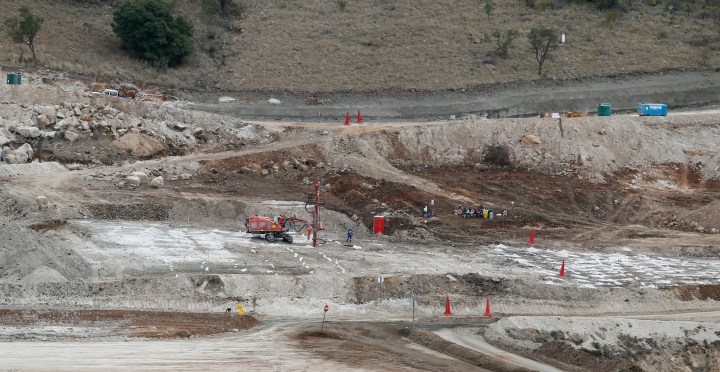BUSINESS REFLECTION
Loaded for Bear: The R400m Junior Mining Exploration Fund is pie in the sky

The R400m Junior Mining Exploration Fund, unveiled at last week’s African Mining Indaba in Cape Town, is almost certainly a disaster waiting to happen.
The Junior Mining Exploration Fund (JMEF) looks good at first glance – a welcome initiative to help junior mining companies send geologists into the South African hills, rock hammers in hand.
“The main objective of the fund is to enable eligible South African junior mining enterprises to access funding so they can conduct prospecting work; increase access to mine ore bodies, and promote economic inclusion to support equitable economic growth,” the Department of Mineral Resources and Energy (DMRE) and the Industrial Development Corporation (IDC) said in a joint statement.
South Africa’s exploration woes are well known and are embedded in the opaque labyrinth of seams that lie beneath piles of paper in the offices of the DMRE.
Despite vast mineral and metals wealth and sophisticated capital markets, exploration activity in South Africa’s mining sector has all but evaporated.
Two decades ago, South Africa accounted for over 5% of global exploration expenditure. This has sunk to below 1% as the country has fallen off investor radar screens.
There are many reasons for this decline, but as this correspondent has banged on about many times, the lack of a functioning mining cadastre and transparent and efficient application system for mining rights of various stripes tops the list.
Read more in Daily Maverick: Mantashe’s missed mining target — SA at less than 1% of global exploration spend
A mining cadastre is now finally on its way after many delays. But the damage has been done.
The useless Samrad system that the DMRE uses for processing mining and prospecting applications has resulted in massive backlogs, which Minerals and Energy Minister Gwede Mantashe last month said stood at around 3,000.
Read more in Daily Maverick: Loaded for Bear: SA’s mining cadastre will take at least a year to be operational
The Minerals Council SA estimates that a pipeline of R30-billion in potential investment and counting has been held up as a result.
So now, in time for the Mining Indaba, the Samrad replacement was announced. And at the Indaba itself, we have R400-million earmarked to support junior miners.
Better late than never, as they say.
And there may be reasons for cautious optimism here.
For starters, the JMEF will be administered and managed by the IDC, which is rarer than a new South African mineral discovery – a relatively well-run state-owned enterprise (SOE) that actually makes money rather than burning it.
Read more in Daily Maverick: After the Bell: A rare sighting of good news for South Africa’s state-owned enterprises
Giving R400-million to the DMRE – which has shown itself to be shambolic on so many fronts – to administer and manage would have been a really bad idea.
I mean, what could possibly have gone wrong?
Exploration needs to be stepped up if South Africa is to have a mining future. Basically, if you don’t find new stuff to mine, no mines are going to be built, finish and klaar.
Pie in the sky
But the JMEF is probably not going to do much to boost prospecting and exploration in South Africa.
For starters, take the regulations in the Mineral and Petroleum Resources Development Act (MPRDA) regarding the granting of prospecting rights.
Section 17 pointedly says: “The Minister must grant a prospecting right if… the applicant has access to financial resources and has the technical ability to conduct the proposed prospecting operation optimally in accordance with the prospecting work programme.”
The statement from the DMRE and ICD says: “The main qualifying criteria require applicants (for JMEF funds) to comply with the South African mining regulatory requirements, including but not limited to the provisions of the MPRDA…”
This raises a number of questions. If you are a qualifying applicant, presumably you already have access to “financial resources”, but, hey, a top-up is always welcome.
Or, perhaps by qualifying for finance from the JMEF, you can meet the criteria of having access to finance? This is hazy territory.
Having the “technical ability” to do proper prospecting is another red flag.
If the aim is to bolster junior mining enterprises, what definition will be used for “junior”? (More on that shortly). And will the bar be set so low that qualifying enterprises lack the technical capabilities?
In this case, providing them with prospecting rights would violate Section 17 of the MPRDA.
Some critics believe this is already the case.
“It is unlawful to grant a prospecting right to parties that have not demonstrated that they have both the technical skills and financial resources to execute the approved prospecting works programme,” Paul Miller, director of consultancy AmaranthCX, told me.
“This fact has been routinely ignored by the DMRE and is the reason why we have 4,500 or so prospecting rights granted but so little actual exploration taking place.”
Miller also noted that it’s really just small change.
“It is a drop in the bucket. The policy and administrative environment is hostile to private funding of exploration, and yet, without any change to either policy or the administrative systems, the minister has set a target of returning to 5% of global exploration spend,” he said.
“Depending on the year and US/ZAR exchange rate, that is between R9bn and R14bn per year. A multi-year deployment of a total R400m is a rounding error against the target, and that is if it is cleanly and effectively deployed.”
Then there are the question marks raised by the definition of a “junior miner”.
“Internationally, junior miners are companies that operate in the early stages of the mining development lifecycle – when mines are just a twinkle in the eye of a geologist,” Miller told me.
“In South Africa, ‘junior’ means small or new entrant – so sand and clay mines, small coal and chrome operators are all considered junior even though their operations are mature in terms of their place in the mining life cycle. This deliberately incorrect use of the definition hurts exploration.”
Such operators require other kinds of assistance, such as reliable power, roads that are maintained and a conducive policy environment.
Exploration, by contrast, requires serious science and technical capacity and truckloads of money.
It also requires the long-delayed mining cadastre and an applications process that actually functions.
Another red flag is this nugget from last week’s statement announcing the fund:
“DMRE, supported by the Council for Geoscience, will determine the minerals whose exploration can be funded through this initiative.”
Mantashe’s affection for coal is well known, and much of the stuff up in the application process appears to be linked to the issuing of dodgy permits for small-scale coal mining in Mpumalanga.
I mean, what could possibly go wrong? DM



















No whiff here, a vibrant stench in the offing!
The article is fair comment, but jaded opinion outweighs the quoted expertise. The Junior Mining Exploration Fund (JMEF) is more than ‘good at a first glance.’ It represents a positive change in attitude by the government.
In 2017 Parliament published a report by the portfolio committee responsible for mining after a study tour to Western Australia.
Parliament told the executive: “It is imperative that the government and the National Treasury recognise the need to support, much more strongly, the programmes of the Council for Geoscience and the junior and emergent mining sector in South Africa.”
The Australian miners told the committee that “the starkest difference between Australia and South Africa in mining lies in the area of exploration. Australia has a thriving exploration sector, driven by so-called “junior” mining companies, valued below $100-m. with about 600 listed on the stock exchange. $428-m is spent annually on mineral exploration. In South Africa, for various reasons, exploration has really slowed down.”
Junior exploration companies have no producing assets and raise money for their activities on the stock exchange. This can be as little as $3-million or even less. The companies go into hibernation when the commodity cycle dips, but they may have to raise $1-m annually for exploration expenditure just to keep rights to their tenement.
Professor Sam Spearing is the director of the Western Australia School of Mines (WASM) at Curtin University in Perth. He told the delegation: “Government support for exploration is critical for the future of the mining sector. Major producers are not the explorers. Big companies do not have an incentive to explore – except to understand better the characteristics of the deposits they are presently mining.”
Western Australia was falling behind in exploration, so a concerted programme was developed over the last decade to encourage new exploration. This includes a highly successful Exploration Incentive Scheme that subsidizes junior miners to drill and explore. Academically tested studies have shown that for every million dollars spent promoting exploration, the state has derived $23-m in benefits.
See ATC Reports No. 140─2017. 9 October, pages 25 to 69. – on Parliament’s website
Yes R400-m is not enough – and capacity is weak – but it is a positive beginning.